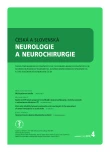Spina bifida in the Czech Republic – incidence and prenatal diagnostics
Authors:
A. Šípek 1-4; V. Gregor 1,3; A. Šípek jr. 1,5; Natálie Friedová 5
; J. Klaschka 6,7; M. Malý 6,8
; J. Jírová 9
Authors place of work:
Oddělení lékařské genetiky, Thomayerova nemocnice, Praha
1; Oddělení lékařské genetiky, Gennet, Praha
2; Oddělení lékařské genetiky, Sanatorium Pronatal, Praha
3; Ústav lékařské genetiky, 3. LF UK, Praha
4; Ústav biologie a lékařské genetiky, 1. LF UK a VFN v Praze
5; Ústav informatiky, AV ČR, Praha
6; Ústav biofyziky a informatiky 1. LF UK, Praha
7; Státní zdravotní ústav, Praha
8; Ústav zdravotnických informací, a statistiky, ČR, Praha
9
Published in the journal:
Cesk Slov Neurol N 2019; 82(4): 410-414
Category:
Původní práce
doi:
https://doi.org/10.14735/amcsnn2019410
Summary
Aim: Retrospective epidemiological analysis of the incidence and prenatal diagnosis of spina bifida in the Czech Republic from 1994–2015 taken from the databases of the National Registry of Congenital Defects (NRVV) and data from the Czech Society of Medical Genetics and Genomics.
Materials and methods: We used the data from the NRVV kept in the Register of Reproductive Health at the Institute of Health Information and Statistics of Czech Republic from 1994–2015. The second source were data on prenatal diagnosis collected under the guidance of the Czech Society of Medical Genetics and Genomics. In our work, we analyzed the annual frequencies and their changes in both born children and prenatally-diagnosed cases. We also analyzed weeks of pregnancy in prenatally-diagnosed cases.
Results: From 1994–2015, 981 cases of spina bifida were diagnosed. Prenatally-diagnosed spina bifida and pregnancies that were prematurely terminated included 635 cases, while 346 cases were detected in infants. In relative numbers, the overall incidence rate was 4.36, the incidence of prenatally-diagnosed cases was 2.82, and 1.54 in newborns (per 10,000 live births). The effectiveness of prenatal diagnosis (P < 0.001) and the incidence of prenatally-diagnosed cases (P < 0.001) increased significantly. At the same time, there was a statistically significant decrease in the incidence in newborns (P < 0.001). Both of these trends went against each other, therefore the overall trend was not statistically significant (P = 0.082). There was no change in the pregnancy week during prenatal diagnosis.
Conclusion: Due to the successful prenatal diagnosis, there was a statically significant decrease in the diagnosis of spina bifida in children born during the observed period.
The authors declare they have no potential conflicts of interest concerning drugs, products, or services used in the study.
The Editorial Board declares that the manuscript met the ICMJE “uniform requirements” for biomedical papers.
捷克共和国的脊柱裂–发病率和产前诊断
目的:捷克共和国1994-2015年脊柱裂发病率和产前诊断的回顾性流行病学分析,来自国家先天性缺陷登记处(NRVV)数据库和捷克医学遗传学和基因组学学会的数据。
材料和方法:我们使用了1994-2015年捷克共和国卫生信息与统计研究所生殖健康登记册中保存的NRVV数据。第二个来源是在捷克医学遗传学和基因组学学会的指导下收集的产前诊断数据。在我们的工作中,我们分析了出生儿童和产前诊断病例的年度频率及其变化。我们还分析了产前诊断病例的怀孕几周。
结果:从1994年至2015年,诊断出981例脊柱裂。产前诊断的脊柱裂和早产终止包括635例,而婴儿中检出346例。相对而言,总发病率为4.36,产前诊断病例的发病率为2.82,新生儿(每10,000活产婴儿)为1.54。产前诊断的有效性(P <0.001)和产前诊断病例的发生率(P <0.001)显着增加。同时,新生儿的发生率有统计学上的显着下降(P <0.001)。这两个趋势相互矛盾,因此总体趋势在统计上并不显着(P = 0.082)。产前诊断期间,怀孕周没有变化。
结论:由于成功的产前诊断,在此期间出生的儿童中脊柱裂的诊断静态减少。
关键词:神经管缺陷–先天性异常–捷克共和国
Keywords:
Czech Republic – neural tube defects – congenital abnormalities
Zdroje
1. Greene ND, Copp AJ. Neural tube defects. Annu Rev Neurosci 2014; 37: 221–242. doi: 10.1146/ annurev-neuro-062012-170354.
2. Copp AJ, Greene ND. Genetics and development of neural tube defects. J Pathol 2010; 220(2): 217–230. doi: 10.1002/ path.2643.
3. Au KS, Ashley-Koch A, Northrup H. Epidemiologic and genetic aspects of spina bifida and other neural tube defects. Dev Disabil Res Rev 2010; 16(1): 6–15. doi: 10.1002/ ddrr.93.
4. Copp AJ, Stanier P, Greene ND. Neural tube defects: recent advances, unsolved questions, and controversies. Lancet Neurol 2013; 12(8): 799–810. doi: 10.1016/ S1474-4422(13)70110-8.
5. Fletcher JM, Brei TJ. Spina bifida – a multidisciplinary perspective. Dev Disabil Res Rev 2010; 16(1): 1–5. doi: 10.1002/ ddrr.101.
6. Mohd-Zin SW, Marwan AI, Abou Chaar MK et al. Spina bifida: pathogenesis, mechanisms, and genes in mice and humans. Scientifica (Cairo) 2017; 2017: 5364827. doi: 10.1155/ 2017/ 5364827.
7. Coleman BG, Langer JE, Horii SC. The diagnostic features of spina bifida: the role of ultrasound. Fetal Diagn
Ther 2015; 37(3): 179–196. doi: 10.1159/ 000364806.
8. Loucký J, Springer D, Šubrt I. Doporučení o laboratorním screeningu vrozených vývojových vad v prvním a druhém trimestru těhotenství. Klin Biochem Metab 2015; 23(44): 27–30.
9. Hardin JW, Hilbe JM. Generalized linear models and extensions. 4th ed. College Station: A Stata Press Publication 2012.
10. Šípek A, Gregor V, Horáček J et al. National Registry of Congenital Anomalies of the Czech Republic: commemorating 50 years of the official registration. Cent Eur J Public Health 2014; 22(4): 287–288. doi: 10.21101/ cejph.a4201.
11. Gregor V, Šípek A, Horáček J et al. Týden těhotenství při prenatální diagnostice vrozených vad v České republice, 1996–2002. Česká Gynekol 2004; 69 (Suppl 1): 53–59.
12. Gregor V, Šípek A, Horáček J et al. Vliv prenatální diagnostiky na četnosti vrozených vad v České republice v roce 2004. Česká Gynekol 2006; 71(5): 373–380.
13. Šípek A, Gregor V, Šípek A Jr et al. Vrozené vady v České republice v období 1994–2007. Česká Gynekol 2009; 74(1): 31–44.
14. Gregor V, Šípek A Jr, Horáček J et al. Prenatální diagnostika vrozených vad v České republice – patnáctileté období. Česká Gynekol 2012; 77(5): 437–444.
15. The International Centre on Birth Defects – ICBDSR Centre. Annual Report – 2014. Rome 2015: 208. [online]. Available from URL: http: / / www.icbdsr.org/ wp-content/ annual_report/ Report2014.pdf.
16. Šípek A, Gregor V, Horáček J et al. Incidence vybraných vrozených vad v České republice. Vrozené vady centrálního nervového systému a gastrointestinálního traktu. Epidemiol Mikrobiol Imunol 2015; 64(1): 47–53.
17. Botto LD, Lisi A, Bower C et al. Trends of selected malformations in relation to folic acid recommendations and fortification. Birth Defects Res A Clin Mol Teratol 2006; 76(10): 693–705. doi: 10.1002/ bdra.20307.
18. Šípek A Jr, Gregor V, Šípek A et al. Primární prevence vrozených vad a úloha kyseliny listové. Actual Gyn 2013; 5: 47–51.
Štítky
Detská neurológia Neurochirurgia NeurológiaČlánok vyšiel v časopise
Česká a slovenská neurologie a neurochirurgie

2019 Číslo 4
- Metamizol jako analgetikum první volby: kdy, pro koho, jak a proč?
- MUDr. Lenka Klimešová: Multiodborová vizita je kľúč k efektívnejšej perioperačnej liečbe chronickej bolesti
- Realita liečby bolesti v paliatívnej starostlivosti v Nemecku
Najčítanejšie v tomto čísle
- Multisystémová atrofie
- Dehiscence horního polokruhovitého kanálku
- Spina bifida v České republice – incidence a prenatální diagnostika
- Postižení sluchu po spinální anestezii
